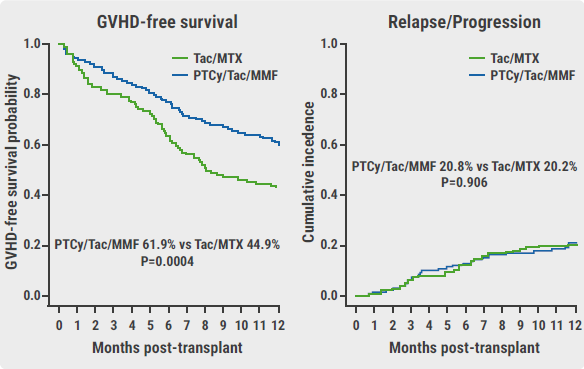https://doi.org/10.55788/6deef4d2
A complete remission (CR) in advance to allo-HCT is an advantageous factor for patients with AML. Thus far, it has not been thoroughly investigated whether intensive chemotherapy, with the goal to induce remission, before allo-HCT results in better outcomes than sequential conditioning and allo-HCT in patients with relapsed/refractory AML. To assess this matter, the EATL3-ASAP trial (NCT02461537) randomised 182 patients with relapsed/refractory AML who were eligible for intensive chemotherapy and allo-HCT 1:1 to either:
- High-dose cytarabine and mitoxantrone, followed by allo-HCT; or
- Disease control: recommended watchful waiting but permission of low-dose cytarabine (LDAC) and single doses of mitoxantrone, followed by sequential conditioning, and allo-HCT.
The primary outcome was the CR rate at day 56 after allo-HCT. Prof. Matthias Stelljes (University of Muenster, Germany) presented the results [1].
In total, 76% of the participants in the disease-control arm did not need disease-control measures until the start of sequential conditioning. The primary endpoint did not reveal a significant difference between the disease control arm and the chemotherapy arm, with 84.1% and 81.3% of the participants achieving a CR at day 56 after allo-HCT, respectively (non-inferiority P=0.047). Moreover, the 1-year leukaemia-free survival rates following CR at day 56 were 71.5% in the disease-control arm and 69.9% in the chemotherapy arm (P=0.8). Finally, the 3-year overall survival rates were comparable, with 51.0% in the disease control arm and 54.2% in the chemotherapy arm (log-rank P=0.47). The disease control strategy resulted in fewer grade ³3 adverse events than the chemotherapy arm (23% vs 64%; P<0.001). Also, the number of days spent in the hospital prior to allo-HCT was significantly reduced in the disease-control arm compared with the chemotherapy arm (19 vs 42; P<0.001).
In conclusion, the current study showed that patients with relapsed or refractory AML did not achieve improved long-term outcomes if they received salvage chemotherapy in advance of allo-HCT, suggesting that a minimal disease burden is not necessarily a pre-requisite for good outcomes after allo-HCT.
- Stelljes M, et al. In Patients with Relapsed/Refractory AML Sequential Conditioning and Immediate Allogeneic Stem Cell Transplantation (allo-HCT) Results in Similar Overall and Leukemia-Free Survival Compared to Intensive Remission Induction Chemotherapy Followed ByAllo-HCT: Results from the Randomized Phase III ASAP Trial. Abstract 4, ASH 64th Annual Meeting, 10–13 December 2022, New Orleans, LA, USA.
Copyright ©2023 Medicom Medical Publishers
Posted on
Previous Article
« Blinatumomab candidate for standard-of-care in newly diagnosed B-ALL Next Article
Promising results for triplet therapy with magrolimab in AML »
« Blinatumomab candidate for standard-of-care in newly diagnosed B-ALL Next Article
Promising results for triplet therapy with magrolimab in AML »
Table of Contents: ASH 2022
Featured articles
Acute Lymphoblastic Leukaemia
Blinatumomab candidate for standard-of-care in newly diagnosed B-ALL
High-dose methotrexate or standard interim maintenance in young patients with ALL?
Acute Myeloid Leukaemia
Excellent results for triplet regimen in FLT3-mutated AML
MRD by qPCR prognostic of outcomes in venetoclax-treated NPM1-mutated AML
Promising results for triplet therapy with magrolimab in AML
Should we use intensive chemotherapy prior to allo-HCT in relapsed/refractory AML?
Chronic Leukaemia
Zanubrutinib wins battle of BTK inhibitors in relapsed or refractory CLL/SLL
Ibrutinib plus venetoclax displays long-term benefits in CLL
Multiple Myeloma
Talquetamab further investigated in heavily pre-treated MM after promising phase 2 data
Promising results of elranatamab for MM in phase 2 MagnetisMM-3 trial
Deep and durable responses for quadruple therapy in smouldering MM
Ultra-sensitive MRD assessment in MM with BloodFlow
CAR-Hematotox score proves useful in relapsed/refractory MM
Head-to-head: VMP versus Rd in transplant-ineligible MM
Lymphoma
Ibrutinib added to ASCT improves clinical outcomes in mantle cell lymphoma
High-dose chemotherapy plus ASCT superior to standard immuno-chemotherapy in primary CNS lymphoma
Odronextamab has considerable anti-tumour effects in relapsed/refractory diffuse large B-cell lymphoma and follicular lymphoma
Excellent results for AFM13-complexed NK cells in CD30-positive lymphoma
CAR-Hematotox score predicts toxicity, infections, and clinical outcomes in MCL
Myeloproliferative Neoplasms
Efgartigimod successful in immune thrombocytopenia
INCA033989: novel investigational agent for CALR-mutated MPN
Ruxolitinib mediates clonal evolution of RAS pathway mutations in MPN
Immune Thrombocytopenia
Long-term risk for haematologic disease in persistent, isolated mild thrombocytopenia
Various Topics
C1 inhibitor deficiency linked to thrombosis
Durable responses to gene therapy in haemophilia A
Long-term benefits from beti-cel in transfusion-dependent β-thalassaemia
Neutrodiet: non-restricted diet is the preferred option after SCT
Iptacopan offers solution for patients with PNH and residual anaemia after standard-of-care
Novel therapy may replace standard-of-care prophylaxis for GVHD
LMWH does not result in higher live birth rates in women with inherited thrombophilia
Related Articles

February 20, 2023
Novel therapy may replace standard-of-care prophylaxis for GVHD
February 20, 2023
Long-term benefits from beti-cel in transfusion-dependent β-thalassaemia
© 2024 Medicom Medical Publishers. All rights reserved. Terms and Conditions | Privacy Policy

